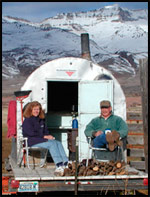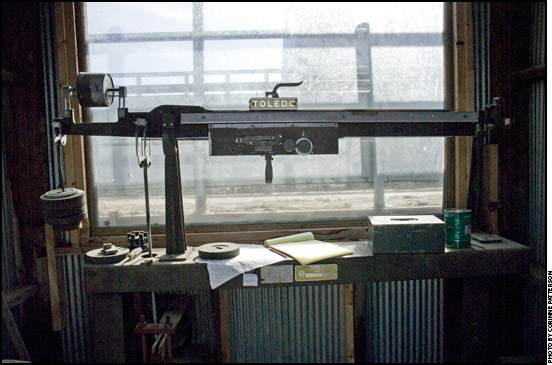MANAGEMENT...
Scales a Valuable Tool for Every
Cattle Producer
At some point in the life of most beef cattle, they will run over a scale to establish their market value. After they are harvested, the animal's carcass weight is used to arrive at the true worth as beef, said Eldon Cole, a livestock specialist with University of Missouri (MU) Extension.
"Besides using a set of scales to arrive at the market value for cattle, scales also help determine genetic merit," Cole said.
Weights taken at birth, weaning, yearling and harvest time are the basis for the development of expected progeny difference (EPD) data used in making breeding stock and promotion decisions. The EPD is viewed as a powerful tool when making objective decisions.
"A scale also helps reduce over- or under-dosing medications. Since most of those products are administered based on weights, it's possible to save several cents or even dollars per head when you know the true weight," Cole said. Read more.

Ron Torell with his wife, Jackie
Cow Camp Chatter
The second trimester: Opportunity!
Opportunity can best describe the second trimester of a cow's pregnancy. Of the four biological periods of the beef cow's cycle, the second trimester is the least demanding of nutrients. This means that the second trimester of pregnancy is an opportune time to improve the body condition of cows through the use of high-roughage standing forage. By stockpiling body condition, we are lowering the winter feeding cost and setting the cow up to succeed in next year's production cycle. This is a win/win situation. Read more.
Timely Bale Removal Important to Hay Yields
Hauling bales from the field and getting them under cover can be important to maintaining quality of recently harvested hay, particularly in wet climates. Whether it is wet or dry, however, timely bale removal can prevent future yield losses.
"The longer you wait, the greater is the potential for plant damage from wheel traffic. Regrowth is under way, and traffic causes breakage of elongating stems. That can reduce yields of subsequent cuttings," says Daren Redfearn, Oklahoma State University Extension forage specialist. "The damage can reduce production of grasses too, but it's a bigger problem with alfalfa and other legumes."
A three-year study of wheel traffic effect on Wisconsin alfalfa fields suggests about 50% of the total plants will be affected by stem breakage occurring during cutting, baling and hauling the crop.
Another study of fields in Wisconsin, Minnesota, Iowa, New York, Nebraska and Oklahoma compared the effects of wheel traffic occurring two days and five days after cutting. On average, damage from traffic two days after harvest resulted in approximately 5% reduction in subsequent yield. After five days, however, the yield reduction was about 20%. Based on the study data, producers are likely to lose close to 6% of future yield for each day they wait postharvest.
Redfearn recommends limiting trips across fields whenever possible. Merging light windrows, for example, will result in less travel with a baler. Pulling a rake or baler with something other than a large loader tractor with dual wheels will also result in less damage. And try to avoid driving all over the field when removing bales.
"Producers should try to remove hay from their fields quickly, but they have to be practical," Redfearn advises. "You don't want to rut up a field by hauling hay when it's muddy. Do it as soon as you can but use common sense."
Keep Expenses in Check
Extension expert says those in the cattle business should be cautious of spending too much on metal.
Watching the bottom line in an operation is more important than ever in the cattle business, and there's not much room for equipment-related purchases that aren't absolutely necessary, said an expert with the Texas AgriLife Extension Service. At the 2010 Texas A&M Beef Cattle Short Course in College Station, ranchers were reminded not to get carried away with buying too much equipment to manage an operation. Read more.
Alfalfa Planting Is Around the Corner
When rain has been plentiful, late summer and early fall are ideal times for planting alfalfa in Kansas.
Alfalfa planting is drawing near in many parts of Kansas thanks to the rainfall.
According to Jim Shroyer, crop production specialist with Kansas State University Research and Extension, late summer and early fall are ideal times for planting alfalfa in Kansas when there has been plenty of rain. He said growers in northwest Kansas can plant as early as Aug. 10-15, while those in southeast Kansas can wait until mid- to late-September.
"Producers just need to plant early enough to have three to five trifoliate leaves before the first frost," he said.
"If managed properly and if we have a good year in terms of weather, dryland alfalfa can produce 4 to 6 tons of forage per acre per year," Shroyer said. "Irrigated fields can produce 8 to 12 tons per acre per year." Read more.

Kris Ringwall
Beef Talk
Feeding cattle adds balance to the cow-calf operation.
Staying connected in the beef business is important, but is it worth retaining ownership?
The cattle business is very dynamic, so it is very easy to get lost in the shuffle. The current news or the latest color print catches our eyes and we start talking. Our conversations tend to be filled with lots of thoughts sprinkled with a few facts. The facts are seldom our own and actually may be slightly biased at times by someone having a quick change of expression or a shift in body language.
That is why keeping our own records helps make sense of the information that is sent our way on a quiet day. Read more.
New Products
Industry affiliates provide a wide array of products and services to assist you on the farm and ranch. Here's an assortment of new products to hit the market recently.
• Improved supplement or replacement
• Customized local weather reports
• Ag app
'Super Socks' Help Stem Pollution Runoff
Agricultural Research Service (ARS) scientists and their collaborators have improved on an existing method for removing contaminants from stormwater runoff. These findings could provide surface waters additional protection against runoff containing pollutants from point sources such as construction sites, stormwaters and other urban landscapes.
"Filter socks" containing compost tucked into mesh tubes are used to capture some of the silt, heavy metals, fertilizers and petroleum products washed from compacted surface areas into nearby streams and rivers. Read more.
Angus Advisor
Click here for August herd management tips from cattle experts across the nation. Advice separated by region.
[Click here to go to the top of the page.]





